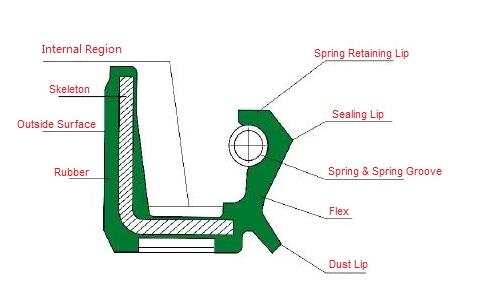The Isi-Star device can cure UV inks at the speed of the press at full speed, and the output power can be adjusted to avoid over-curing. In addition, the drying control can be integrated with the control of the entire printing process, which allows the operator to set the operating parameters of each drying device when operating the printing press. These settings are stored in the job serial number. When the machine performs a repetitive operation, the settings of the UV device can be restored and can be preset automatically. The low emergency power of the Isi-Star device can reduce energy consumption and reduce the heat generated by the lamp when the machine is stopped. To match the spectral output of the photoinitiator in the UV ink, the Isi-Star device can be doped with a mercury vapor lamp, neon, or iron.
Oil Seal is a mechanical components that used to seal oil (oil is the most common transmission system liquid material), It`s isolated the lubricated components with other components, not let the lubricate oil leakage.
Oil Seal is generally divided into single-type and assembly type, assembly type is the skeleton and lip material can be free combination, generally used for special oil seals.
Oil seal can have different names, customary general rotary axis lip seal called oil seal, the static seal and dynamic seal (general reciprocating motion) was called seal parts.
The representative form of oil seal is TC type, is a double lips oil seal with a fully rubber coated and garter spring, generally speaking oil seal refers to TC skeleton oil seal, skeleton oil seal diagram see Figure:

Generally when the oil seal is working ,its lips area temperature is higher 20-50℃ than working medium. Make sure you noted this when you select the oil seal products.
Oil seal operating range is related to its material:
NBR: -40 to 120℃,
ACM: -30~180℃
FPM: -25~300℃
Application:
Any operate case which have liquid lubricants inside and need to connect with outside also, the connect place is required of oil seals.
Engine: crankshaft - crankshaft front and rear oil seal, valve - valve oil seal (engine repair kit o-ring) (distributor oil seal, pump oil seal, balance shaft oil seal, oil pump seal ...);
Camshaft - camshaft oil seal ; Transmission: transmission front oil seal, transmission rear oil seal, transmission shift oil seal (transmission repair kits o-ring)
Sub actuator front oil seal, Sub actuator rear oil seal,
rear axle: axle oil seal
Rear Wheel Oil Seal
Front Wheel Oil Seal
Directional Oil Seal (Directional Machine Repair Kit o - ring)
Directional Booster Oil Seal (Front Axle Oil Seal).
Air compressor crankshaft oil seal
Oil Seal
Oil Seal,Silicone Rubber Oil Seal,TC Oil Seal,Valve Stem Oil Seal
HAFID INTERNATIONAL LIMITED , http://www.hapgasket.com
![<?echo $_SERVER['SERVER_NAME'];?>](/template/twentyseventeen/skin/images/header.jpg)